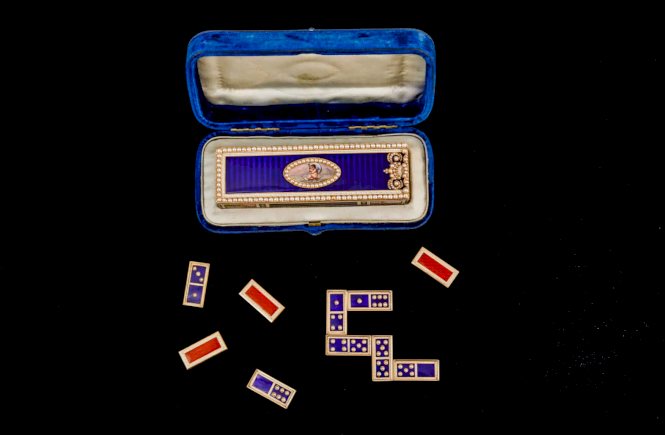Queen Victoria’s domino set to be offered at Sotheby’s London
Estimated at £250,000-400,000 the exquisite pearl and enamel musical domino box by Bautte is one of the most exquisite examples of early 19th-century Geneva workmanship
Dominoes was said to be one of Queen Victoria and Prince Albert’s favourite pastimes
A rectangular blue enamel and pearl encrusted domino box once belonging to Queen Victoria is set to come to auction on July 5th, 2022, at Sotheby’s London as part of the upcoming Treasures sale. One of the most exquisite examples of Geneva workmanship from the early nineteenth century, the set is estimated to fetch between £250,000-400,000.
Playing dominoes was said to be one of Queen Victoria’s favourite pastimes, with the game mentioned nearly 40 times in her journal between 1839 and 1861. The Queen, who ruled between 1837 and 1901, particularly loved to play the game with her husband Prince Albert. In one entry from Sunday December 18th 1842, which was spent at Windsor Castle, she writes: “Albert read to me, and we played at dominos, such a good game.” However, after his death in 1861, reference to the game ceased to be recorded and it is purported that she gave the present musical domino set to her youngest son, Prince Leopold, Duke of Albany who was a lover of games and held the 1883 London Chess Tournament under his patronage. The set was passed down through the descendants of Prince Leopold until it appeared at auction nearly 40 years ago when acquired by the current owners.
Created in Geneva between 1804-1808 by Jean-François Bautte (1772-1837) the solid gold case overlaid with translucent blue enamel is an incredibly rare amusement piece, with only one other example recorded so far.
Bautte – the most renowned jeweler in the city in the late eighteenth and early nineteenth century was part of the so called Geneva Fabrique which was a tightly knit community of merchants, watchmakers, casemakers and goldsmiths was one of the largest employers in Geneva at the end of the 18th century. Well known to the experienced eye in Paris and London, Bautte’s work caught the attention of Queen Victoria partially thanks to the famous art critic and Victorian polymath John Ruskin (1819-1900), who published his report on Bautte the year after she became Queen.
The charming domino set with its playful decoration is relatively small in size. A matching oval pearl-set gold and enamel key winds the musical movement revealed by the sliding lid. Matching their container, the 28 counters are enameled in translucent blue with their numbers formed of split-pearls. The silk-lined velvet case also features a paper label with the Saxe-Coburg-Gotha coat of arms on the underside. The sides of the enamel box have four vignettes representing the four seasons: picking flowers for the spring, wine drinking in the summer, the harvest in the autumn and ice skating in winter. The lid of the box is enamelled with a sailing Cupid on his quiver.
The game of Dominoes arrived in Europe in the early 18th century, probably first brought back by Italian missionaries returning from the Far East who are said to have adapted the Chinese version by adding an additional seven dominoes. Furthermore, during the 1780s, the industrious Swiss watch and enamel industry created marvelous pocket watches and objects of vertu for the extremely lucrative Chinese Market, as well as for export to the Ottoman market. It was towards the end of the 18th century that the game of dominoes reached Britain.

